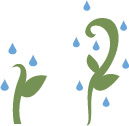
Watering 101
Watering 101
Watering properly will not only help your landscape flourish, but also save on water, so read on to learn the best watering practices for your landscape.
Looking for local rebates from water districts? Visit BeWaterSmart.info.
Looking for local rebates from water districts? Visit BeWaterSmart.info.

Newly Planted vs. Established Plants
New plants require more frequent, deep watering until a wider, deeper root system is established. Once established, it's time to adjust to a less frequent, yet deep watering schedule.
Read on for information on how to develop that deep root zone: Drought Tolerant Plants
Read on for information on how to develop that deep root zone: Drought Tolerant Plants
Container Plants vs. In-Ground Plants
The same plant will require more water more often when planted in a pot vs. in the ground. Pots can keep root zones small and the soil in containers drain faster than most soils.
Once Established, Plants Settle Into High, Moderate, Low, or Very Low Water Needs
- High: Requires deep, frequent watering during our summers.
- Moderate: Requires deep watering, but the soil should dry out a few inches before watering again. In dry years, it may only need watering 1-2 days per week.
- Low: Still requires deep watering, but less often, letting the soil dry out even further before watering again. Possibly as little as every 2-3 weeks even during our hot, dry summers.
- Very Low: Once established, these plants only get watered by you if spring rainfall was below average.


Sandy Soil
Coarse texture, large pores
- Doesn’t hold moisture well.
- Soil drains quickly.
- Plants may need more frequent watering.

Loamy Soil
Medium texture, ideal soil!
- Composed of clay, silt, and often organic matter. (You read that right—having some clay makes for ideal soil!)
- Holds moisture well.
- Check soil in between watering to prevent over-watering. Use a water meter or your finger to find out if it is time to water.

Clay Soil
Fine texture, very small pores
- Retains water a long time and doesn’t drain quickly.
- Needs slow, deep watering to allow the water to percolate down to the root zone. Drip is ideal for clay soils. Hoses and sprinklers put out water too fast for clay to get a deep soaking.


Size
Typically, the larger the plant the more water it will need, unless the plant is established and drought tolerant.

Location
Determine how much sun your plant is getting throughout the day. Adjust watering times on irrigation systems accordingly.


Spring
The ground is warming up and plants are coming out of dormancy.
Drip Irrigation
- Adjust watering schedule according to weather and water district recommendations.
- Trees and shrubs should run on separate valves because their watering requirements differ.
- Add more emitters and place them at the drip edge of the plant as it grows. The drip edge is the furthest reach of the branches.
Plant Specifics
- New plantings: keep soil moist, but not soggy.
- Established plants: allow soil to dry slightly as the plant reaches maturity, and increase the depth of dry soil before watering again once the plant is fully established. Full establishment can take two to three years of root growth.

Summer
- Soil should not be soggy, especially overnight. This increases disease and pest development.
- Daytime temps can be extreme; however a wilting plant does not always mean more water. Check the soil to see if it's dry before adding more water.
Drip Irrigation
- Check drip emitters for leaks and proper flow.
- Add more emitters and place them at the drip edge of the plant as it grows.
Plant Specifics
- Small plants with small root zones need watering more often.
- Established shrubs and trees need deep, infrequent watering.
- Established natives need only occasional watering; possibly soaking every two to three weeks.

Fall
Warm daytime temperatures and cool evenings.
Drip Irrigation
- Monitor drip according to temperatures. As plants slow their growth for the year, they might need water less often.
- Add more emitters and place them at the drip edge of the plant as it grows.

Winter
- The ground is cold and will retain water longer.
- Keep soil from going completely dry.
- During a freeze and times of drying north winds, it’s crucial for plants to be hydrated.
- Water before applying frost cloth to insulate your plants.
Drip Irrigation
- Adjust according to weather. Irrigation systems can be turned off during winter.
- Supplement by hand watering potted plants or in-ground plants as needed while the irrigation system is off.
- Continue to add more emitters and place them at the drip edge of the plant as the plant grows.
Plant Specifics
- Most shrubs and trees are dormant in winter, but still require occasional watering when rainfall is below average.
